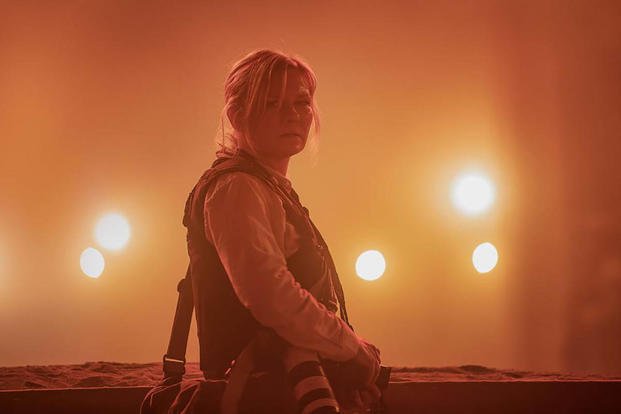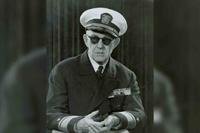You would be forgiven for thinking that “Civil War” was a movie about the bloodiest U.S. conflict dating back to the late 19th century. Instead, it’s a prescient look at a fictional, fractured, near-future America.
Directed by Alex Garland (“Ex Machina”) and produced by independent entertainment company A24, the film opens with an unnamed president (Nick Offerman) practicing a self-assured speech about the strength and unity of the United States juxtaposed against scenes of chaos, violence and destruction erupting across the country.
Meanwhile, veteran Reuters journalist Lee (Kirsten Dunst) sits in a New York City hotel room as an explosion erupts outside her window. Her team, which consists of alcoholic thrill-seeker Joel (Wagner Moura), her elderly mentor Sammy (Stephen McKinley Henderson) and a stowaway newcomer Jessie (Cailee Spaeny), plans to make the treacherous drive from Manhattan to Washington, D.C., to try to confront the president, who has held three terms in office but nary a press conference.
Told from the perspective of Lee and her Reuters colleagues, it’s obvious early on in “Civil War” that the conflict has been lengthy and is nearing an end. As Joel remarks of their mission to find the president, “interviewing him is the only story left.” But with opposition troops closing in on the Capitol, their trip is billed as a suicide mission.
Before striking out on the road, Lee, who has covered combat and conflict from the early aughts through the next two decades, is haunted by visions of destruction as she soaks in a hotel bathtub. However, war for her has become something of a drug; she’s addicted to it, even though she knows how bad it is for her.
What’s striking about “Civil War” is that the history of this conflict is left relatively untouched. We don’t know how it started, what role politics played in developing the factions or when it began; we know that California and Texas are somehow allies and that Florida is recruiting secessionists. However, as the crew drives along what looks like the remnants of I-95, it’s obvious how normal war has become -- and how viscerally terrible that is.
Garland hired technical advisers, including several military veterans, to ensure the authenticity of the on-screen experience. One of them was former Navy SEAL Ray Mendoza, who applied what he saw over 17 years in service to create the scenes of urban (and suburban) warfare shown throughout the film.
“This movie is not meant to scare people, but more to illustrate the consequences and reality of what warfare would look like in their neighborhood or on their street,” Mendoza, who served with SEAL Team 5, recently told Military.com. “It’s more of a cautionary tale.”
One of the most haunting scenes -- and there are many -- is perhaps one of its quietest and most sobering. It takes place at dusk in an abandoned JCPenney north of D.C., wherein the only vehicle parked in the lot is a downed helicopter.
The backdrop of the department store is clearly representative of the pinnacle of past American success, its political and economic heyday. The country’s present, however, is as broken and hollowed out as the chopper. And so, too, are its people, including these journalists.
But the combat scenes, too, are grievous. They’re gory, chaotic, loud and authentic in a way that could prove triggering to watch for people who know the pain of war intimately.
The first real taste of combat is an urban shootout, where the Reuters team shadows some plainclothes fighters taking on heavy fire from uniformed forces. It’s marred by bullets, blood and flashbangs. Though there is no explanation of which factions are fighting, the anonymity ultimately enhances the struggle; after all, both sides are former Americans, people who were probably neighbors before the conflict.
The worst scene, however, comes in the form of a kidnapping-turned-execution. Led by a twisted soldier (Jesse Plemons) in the pink heart-shaped glasses made iconic by the movie’s trailer, the gun violence is so cold and inhumane, it’s nauseating.
“I can say firsthand that many of the action sequences were pretty intense, and I could tell a lot of the veterans were ‘locked-in’ in a way that I’ve seen from teammates on combat deployments,” Mendoza added.
Trauma, as a result, becomes a major theme in this story. For the entire duration of the film, dread is everpresent, and each character is pushed to a breaking point in their own way. Lee, for instance, is nearly incapacitated by the sound of gunfire as the team approaches the White House, while Joel drinks himself into oblivion each night to deal with what they are reporting.
The correspondents covering the civil war internalize the worst of humanity in order to play witness to it. Yet they can’t stop. The cycle of trauma and adrenaline is addictive -- not unlike what military observers witness in veterans who develop PTSD but want to keep returning for deployment after deployment.
“By hiring veterans from multiple branches and skill sets to utilize their shared experiences of combat, we curated a noticeable authenticity, which I’m extremely proud of,” Mendoza said.
The resulting film is a warning worth heeding. As politicians toss around phrases such as “national divorce” and “civil war” ahead of a contentious 2024 election cycle, America feels more divided than ever. According to the Institute of Politics and Public Service Battleground Civility Poll from March 2024, 78% of Americans are concerned the election will become violent.
“No one wants to believe that their beloved democracy is in decline, or headed toward war,” political scientist Barbara F. Walter wrote in her 2022 book, “How Civil Wars Start: And How to Stop Them. “[But] if you were an analyst in a foreign country looking at events in America -- the same way you’d look at events in Ukraine or the Ivory Coast or Venezuela -- you would go down a checklist, assessing each of the conditions that make civil war likely. And what you would find is that the United States, a democracy founded more than two centuries ago, has entered very dangerous territory.”
In the end, “Civil War” is not about factions, troops, weapons or politics. It’s a harrowing look at how horrible real-life combat is for everyone, even the observers -- a warning about what actually might happen in our backyards if we can’t find common ground.
“War is not easy,” Mendoza added.
“Civil War” breaks out in theaters on April 12, 2024.
Keep Up With the Best in Military Entertainment
Whether you're looking for news and entertainment, thinking of joining the military or keeping up with military life and benefits, Military.com has you covered. Subscribe to the Military.com newsletter to have military news, updates and resources delivered straight to your inbox.

















